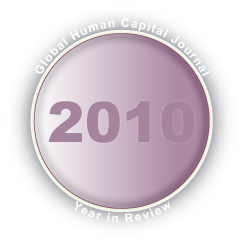2010 Year In Review Initial Glimmers of Social Business is the Editor’s Choice of the Global Human Capital Journal—The Best Strategy, Tactics, Case Studies and Insights of 2010
 Compared to its progenitors 2009 and 2008, 2010 was a relatively calm year because the amplitude of market gyrations was clearly less, and businesses began to find a new floor on which to build stakeholder expectations. Although I watched with high interest the unfolding drama in Europe, I didn’t have the time to conduct the research necessary to do a rigorous interpretation. I did publish a reflection in January, which is not included in this year in review. However, 2010 marked a major turning point in the adoption of social technologies: the recognition that analysis and strategy were necessary to achieve consistent results with social initiatives.
Compared to its progenitors 2009 and 2008, 2010 was a relatively calm year because the amplitude of market gyrations was clearly less, and businesses began to find a new floor on which to build stakeholder expectations. Although I watched with high interest the unfolding drama in Europe, I didn’t have the time to conduct the research necessary to do a rigorous interpretation. I did publish a reflection in January, which is not included in this year in review. However, 2010 marked a major turning point in the adoption of social technologies: the recognition that analysis and strategy were necessary to achieve consistent results with social initiatives.
2010 Macro trends
Social has been in adolescence up through 2009-2010 in which “being on Facebook” was an end in itself, agencies produced vapid content and little interaction happened because people won’t interact when brands are talking at them and not listening. People feel it when a brand is interested in using social tools to promote itself (I call this “social media”). They also feel it when a brand is interested in building relationship, which is marked by active listening and responding, along with a relative absence of self-promotion. Brands that build relationship know that they don’t have to promote themselves if they are truly interested in people: people will promote them. However, this approach is future state for most companies.
The growing use of strategy is also a harbinger for what I call “social business,” in which leaders use social technologies to transform their businesses by collaborating openly with various outside and inside stakeholders to innovate constantly. Early movers will only begin emerging in 2011. Only a few gutsy players will aim to aggressively adopt cutting edge social business practices in 2011. I believe they can change markets.
This Year in Review includes articles from the Social Network Roadmap(SM), MENG Online, the Executive’s Guide to LinkedIn, the Executive’s Guide to Twitter and the Executive’s Guide to Facebook. Heavy client work curtailed my attendance at conferences, but I logged 14 speaking engagements this year, so I also covered some of the other sessions. This year, I have selected twelve articles as Must Read, which are clearly marked in each section, and I ALL-CAPPED five of the best of the Must Reads. Most important, I invite you to share your thoughts and questions in comments.
Economy, Enterprise, Strategy and Adoption
 In 2010, “the economy” slowly improved at a pace of 1.25 steps forward, 1.0 steps back, but enterprises slowly gained confidence that the “period of bad news” was finite and mostly behind them—unless they were in Greece, Ireland or, to a lesser extent, Portugal and Spain. Their adoption of social business was predictable, steady and slow. Most of 2010’s posts highlighted here hail from the Social Network Roadmap(SM) because they focus on the drivers and practice of social business. Heavy client work in 2010 included a Fortune 50 retailer, a global semiconductor manufacturer and a prominent local government on the U.S. east coast. In 2010, executives realized that they needed a more coordinated sense of purpose, a “strategy,” and strategy began maturing social initiatives. Prior to 2010, the mantra was, “Throw a couple of interns at it, they know how to do Facebook.” In 2010, I helped clients clean up some of those messes: activity doesn’t equate to business results. I expect the cleanup phase to continue through 2013 at least because, well, success depends on being social in meaningful ways to customers and practical ways to businesses. From a business perspective, strategy provides the rationale for prolonged focus, which is required because relationships need commitment. Businesses’ commitments must be grounded in business purpose. Being social for its own sake is a short-lived phenomenon. As this section’s “must reads” point out, most businesses don’t know how to “be social” in authentic, meaningful ways. In most cases, it also requires extensive mentoring to learn the tools, processes and behaviors well enough to be natural online. Social knowledge is indeed a key barrier. Also read the “Decade in Review..” to understand the context of where we are today.
In 2010, “the economy” slowly improved at a pace of 1.25 steps forward, 1.0 steps back, but enterprises slowly gained confidence that the “period of bad news” was finite and mostly behind them—unless they were in Greece, Ireland or, to a lesser extent, Portugal and Spain. Their adoption of social business was predictable, steady and slow. Most of 2010’s posts highlighted here hail from the Social Network Roadmap(SM) because they focus on the drivers and practice of social business. Heavy client work in 2010 included a Fortune 50 retailer, a global semiconductor manufacturer and a prominent local government on the U.S. east coast. In 2010, executives realized that they needed a more coordinated sense of purpose, a “strategy,” and strategy began maturing social initiatives. Prior to 2010, the mantra was, “Throw a couple of interns at it, they know how to do Facebook.” In 2010, I helped clients clean up some of those messes: activity doesn’t equate to business results. I expect the cleanup phase to continue through 2013 at least because, well, success depends on being social in meaningful ways to customers and practical ways to businesses. From a business perspective, strategy provides the rationale for prolonged focus, which is required because relationships need commitment. Businesses’ commitments must be grounded in business purpose. Being social for its own sake is a short-lived phenomenon. As this section’s “must reads” point out, most businesses don’t know how to “be social” in authentic, meaningful ways. In most cases, it also requires extensive mentoring to learn the tools, processes and behaviors well enough to be natural online. Social knowledge is indeed a key barrier. Also read the “Decade in Review..” to understand the context of where we are today.
 MUST READ—Enterprise Adoption of Social Business 2010—Social Knowledge Gap a Key Barrier
MUST READ—Enterprise Adoption of Social Business 2010—Social Knowledge Gap a Key Barrier- Must Read—Enterprise Adoption of Social Business – 2010 Midyear Update
- Must Read—Decade in Review 2000-2009/The Rise of Web 2.0, The New Pervasive Human Space
- American Express: The Bearish U.S. Economy Will Drive Social Networking Adoption
- How Social Networks Change the Rules of Sales and Profit
- Alcatel-Lucent Study: Social Networkers Not Very Social
- 2010 Predictions and Recommendations for Web 2.0 and Social Networks
- Social Networking Bootcamp Combines Strategy, Management & Practice
- Social Networking Conference Miami 2010 Wrap
Social Business for Commercial and Government Enterprises
 This year’s posts are jammed with case studies that reflected steady progress with social media by business and government, but most businesses are still at the level of learning the tools; they aren’t yet focused on building durable relationships, which require deeper focus and more sharing. I sponsored a collaborative piece on 2010 predictions, collaborating with 16 executives in my enterprise social networking group on LinkedIn (“17 Visionaries..”). I also shared best practices on social business competency teams, which serve as a virtual PMO to drive enterprise adoption of social business as well as a post on comparing different types of social media consultants. Enterprises are also starting to experiment with geosocial apps and algorithms everywhere, both hallmarks of enterprise 3.0.
This year’s posts are jammed with case studies that reflected steady progress with social media by business and government, but most businesses are still at the level of learning the tools; they aren’t yet focused on building durable relationships, which require deeper focus and more sharing. I sponsored a collaborative piece on 2010 predictions, collaborating with 16 executives in my enterprise social networking group on LinkedIn (“17 Visionaries..”). I also shared best practices on social business competency teams, which serve as a virtual PMO to drive enterprise adoption of social business as well as a post on comparing different types of social media consultants. Enterprises are also starting to experiment with geosocial apps and algorithms everywhere, both hallmarks of enterprise 3.0.
- MUST READ—17 Enterprise Visionaries Release 2010 Predictions for Social Networks, Web 2.0
- Must Read—Social Business Competency Teams: How to Boost Enterprise Social Business Performance and ROI
- Must Read—Comparing Enterprise Social Media Consultants & Providers
- Social Business Summit Case Study: Donna Rossi, Western Union
- Social Business Case Study: Jennifer DeMarco Herskind, Dave & Buster’s
- Fraud in Social Networks: FBI Countercrime Initiatives
- Case Study: IBM’s Experience with B2B Social Business
- Case Study: Social Networking at the CDC
- Case Study: Miami Dolphins Use of Social Networking
- Case Study: Seattle Seahawks & Seattle Sounders
Social Networking Platform Review
 Most CMOs know the names and logos of the major platforms and like their exploding popularity, MySpace notwithstanding, but the lack of in-depth platform knowledge of social media providers produces mediocre success. I encountered many cases of firms just “doing Facebook” because it was popular and, well, who wouldn’t want to be there? It’s disheartening to encounter agency-produced snappy social media speak on Twitter and Facebook, which is far worse than doing nothing for most brands; people can smell it a mile away; brands are just flushing money down the toilet. Likewise, few organizations understand that the power of blogging is largely built on networking and relationship. Two must reads this year discuss network-oriented approaches to building Facebook Pages and blogs. The mind bender post is on LinkedIn body language, which is key to reaching another level of relating online.
Most CMOs know the names and logos of the major platforms and like their exploding popularity, MySpace notwithstanding, but the lack of in-depth platform knowledge of social media providers produces mediocre success. I encountered many cases of firms just “doing Facebook” because it was popular and, well, who wouldn’t want to be there? It’s disheartening to encounter agency-produced snappy social media speak on Twitter and Facebook, which is far worse than doing nothing for most brands; people can smell it a mile away; brands are just flushing money down the toilet. Likewise, few organizations understand that the power of blogging is largely built on networking and relationship. Two must reads this year discuss network-oriented approaches to building Facebook Pages and blogs. The mind bender post is on LinkedIn body language, which is key to reaching another level of relating online.
- MUST READ—Four Steps to Building Facebook Presence, Network-Style
- Must Read—Blogs: The Relationship-Centric Approach to Building Readership
- Social Networking for Professional Services Firms
- How LinkedIn Changes the Economics of Cross-border Relationships
- LinkedIn Body Language: How Touch Creates Stronger Connections
- Blogging: Quick Launch Guide
- Visions of Facebook 2.0
- Suggestions for Facebook: How to Triple Value of Friend Suggestions
- Executive’s Guide to Twitter Releases Free Online Courses
- Introducing Twitter Value Vectors: The Key to Building a Quality Following
Marketing 2.0 and Customer Experience
 In 2010 I was invited to do a series of posts on MENG Online, and this section’s must read hails from that. “Rude Awakening..” debunks word of mouth marketing as a flawed concept, riffing on Don Peppers’ remarks at the Alterian Social Business Summit, which I covered fairly extensively. Most of the speakers emphasized how marketing was changing forever, and most meant it. Others shared marketers’ frustrations with trying to drive social initiatives from a legacy marketing viewpoint; the root of their teeth-gnashing was that relationship building doesn’t fit the style of marketing metrics on which they are currently measured.
In 2010 I was invited to do a series of posts on MENG Online, and this section’s must read hails from that. “Rude Awakening..” debunks word of mouth marketing as a flawed concept, riffing on Don Peppers’ remarks at the Alterian Social Business Summit, which I covered fairly extensively. Most of the speakers emphasized how marketing was changing forever, and most meant it. Others shared marketers’ frustrations with trying to drive social initiatives from a legacy marketing viewpoint; the root of their teeth-gnashing was that relationship building doesn’t fit the style of marketing metrics on which they are currently measured.
- MUST READ—Rude Awakening— Only 15% of Word of Mouth Marketing Campaigns Show Positive Results
- Social Business Summit Keynote, Marketing Changed Forever—Stan Rapp, Engauge
- Social Business Summit Keynote Continues Disruption Theme—Don Peppers, Peppers & Rogers Group
- New Age of Socialized Engagement
- Social Business Summit Panel: Brands at Risk
- How Do You Know if Your Act is Together if You Can’t Measure?
- Social Business Summit CEO Address—David Eldridge, Alterian
Technology
 Although “technology” enjoys shrinking attention in the ongoing adoption of social technologies, 2010 proved once again that it’s critical to keep one’s ear to the ground because technology enables quantum leaps in capability. I covered the accelerating adoption of Web 3.0, in the particular form of geosocial, a specific type of mobile social networking (Foursquare et al). Other must reads here discuss Facebook Connect and Google FriendConnect, Web 2.0-style single sign-on (with benefits ;^). Make sure to delve into the PopTech coverage, which highlights using social tech for social initiatives. I loved meeting Patrick Meier and listening to his story about using Ushahidi in Haiti and Chile.
Although “technology” enjoys shrinking attention in the ongoing adoption of social technologies, 2010 proved once again that it’s critical to keep one’s ear to the ground because technology enables quantum leaps in capability. I covered the accelerating adoption of Web 3.0, in the particular form of geosocial, a specific type of mobile social networking (Foursquare et al). Other must reads here discuss Facebook Connect and Google FriendConnect, Web 2.0-style single sign-on (with benefits ;^). Make sure to delve into the PopTech coverage, which highlights using social tech for social initiatives. I loved meeting Patrick Meier and listening to his story about using Ushahidi in Haiti and Chile.
- MUST READ—Enterprise Adoption of Social Business 2010—Three Technologies to Watch
- Must Read—Are Geosocial Apps Foursquare, Gowalla, Loopt & Brightkite Ready for Prime Time?
- Must Read—PopTech Maps Course of Social Change
- Noodle VII: Tablets Won’t Save Mainstream Media But This Might
- Social Business Technology Preview: Mike Talbot, Alterian
Developments at the Global Human Capital JournalIf you made it this far, I hope you can see that 2010 was an amazing year at the Global Human Capital Journal and its sister pubs. I wish you a fantastic 2011!
|
By the way, we don’t use your email for anything nefarious, and you directly control the contact information we have. |

Leave a Reply
You must be logged in to post a comment.